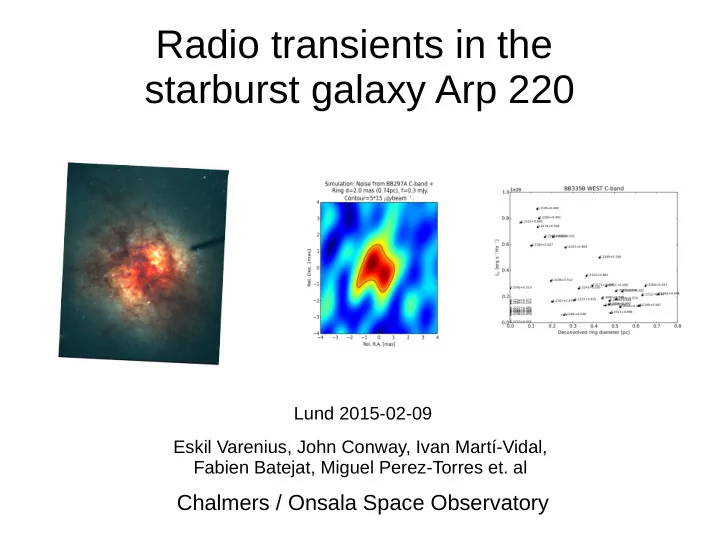

Radio transients in the starburst galaxy Arp 220 Lund 2015-02-09 Eskil Varenius, John Conway, Ivan Martí-Vidal, Fabien Batejat, Miguel Perez-Torres et. al Chalmers / Onsala Space Observatory
Outline ● Arp 220 and the L-D relation ● Months: Rapidly variable sources? ● Years: Supernovae ● Decades: Supernova remnants ● Summary
The starburst galaxy Arp 220 Basic facts ● Closest (77 Mpc) ULIRG (L FIR >10 12 L ☉ ) ● Merger with SFR ~ 100 M ☉ /yr ● Expected radio supernova rate ~ 2 /yr Big picture Study star formation (IMF, magnetic fields etc.) in extreme environments. Top transient science ● Months: Variable sources (AGN? Microquasars?) ● Years: SNe (interacting with CSM) ● Decades: SNR 26’’ (10kpc) HST (interacting with ISM) Wilson et. al (2006)
Deepest image to date: Eastern nucleus 0.25'' 90pc 6cm global radio VLBI Resolution 0.001'', sensitivity 4 μJy beam -1 (Varenius et. al 2015, in prep.)
Deepest image to date: Western nucleus 0.25'' 90pc 6cm global radio VLBI Resolution 0.001'', sensitivity 4 μJy beam -1 (Varenius et. al 2015, in prep.)
20 years of monitoring! ● Dozens of submas-resolution images ● More than 50 sources detected ● Lightcurves, spectra, source sizes... Batejat et. al (2011)
The luminosity-diameter relation (Varenius et. al 2015, in prep.)
L-D relation compared to M82 and LMC Green: Theoretical relation of S α D -9/4 for SNRs in the Sedov phase (Berezhko&Völk 2004) Blue: Best fit of S α D -1.9 Fig. from Batejat et. al (2011)
Months: Variable source (Batejat et. al 2012) 2008-06-10 2008-10-24 2009-02-27 2011-05-16 2014-08-01 2014-10-13
Simulation of ring, PSF, noise 2008-06-10 2008-10-24 2009-02-27 2011-05-16 2014-08-01 2014-10-13
The “variable” sources are large SNRs Large SNRs ~ 150 yr old
Years: New radio supernovae? SNR at their peak, age ~10 yr New SNe?
Years: New radio supernovae? 500 μJy detection limit for Arp220 (Parra et. al 2007) Problem: ● Should see only the brightest radio SNe ● Total SN-rate ~ 2/yr ● Observed SN-rate ~ 2/yr Observed rate is too high! ● SNR/SNe confusion? ● New data will help! ● Big picture: variable IMF Chevalier, 2006, ApJ 641,1029 in dense starburst (e.g. Chabrier et. al 2014)
Decades: Supernova remnants SNR at their peak, age ~10 yr Large SNRs ~ 150 yr old
Decades: Supernova remnants ● Given density n H ~10 4 cm -3 , max radius ~0.35 pc, the largest SNR is ~ 150 years old. (Draine&Woods 1991) ● Assume all SNe produce radio SNRs. Total SN-rate ~2/yr --> should see 300 SNRs. ● We see only 50, i.e. total SN-rate of 0.3/yr. Why so few? Big picture: ● Large sample of SNRs for SNR physics ● SNRs probe densities and magnetic fields of ISM ● Origin of the FIR-Radio correlation
Decades: Supernova remnants SNR at their peak, age ~10 yr New Large SNRs SNe? ~ 150 yr old ?
Summary ● Months: “Variable” sources are likely large SNRs. ● Years: We observe more SNe than expected. Radio SNe probe stellar evolution through CSM. ● Decades: We observe fewer SNRs than expected. SNRs probe ISM, e.g. densities and B-fields. ● Careful analysis of recent very deep images will improve classification of weak SNe and SNRs. ● SNe/SNRs in Arp 220 can help understanding the physics of the FIR-Radio correlation in extreme environments.
Recommend
More recommend